Yifan Zhao
Joint Deblurring and 3D Reconstruction for Macrophotography
Oct 02, 2025
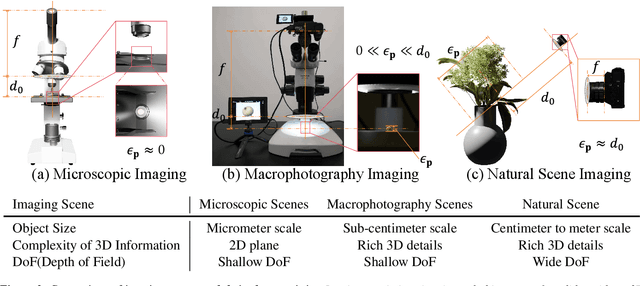
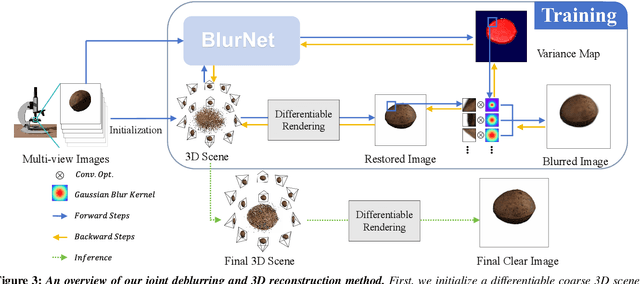

Abstract:Macro lens has the advantages of high resolution and large magnification, and 3D modeling of small and detailed objects can provide richer information. However, defocus blur in macrophotography is a long-standing problem that heavily hinders the clear imaging of the captured objects and high-quality 3D reconstruction of them. Traditional image deblurring methods require a large number of images and annotations, and there is currently no multi-view 3D reconstruction method for macrophotography. In this work, we propose a joint deblurring and 3D reconstruction method for macrophotography. Starting from multi-view blurry images captured, we jointly optimize the clear 3D model of the object and the defocus blur kernel of each pixel. The entire framework adopts a differentiable rendering method to self-supervise the optimization of the 3D model and the defocus blur kernel. Extensive experiments show that from a small number of multi-view images, our proposed method can not only achieve high-quality image deblurring but also recover high-fidelity 3D appearance.
LLMs-guided adaptive compensator: Bringing Adaptivity to Automatic Control Systems with Large Language Models
Jul 28, 2025Abstract:With rapid advances in code generation, reasoning, and problem-solving, Large Language Models (LLMs) are increasingly applied in robotics. Most existing work focuses on high-level tasks such as task decomposition. A few studies have explored the use of LLMs in feedback controller design; however, these efforts are restricted to overly simplified systems, fixed-structure gain tuning, and lack real-world validation. To further investigate LLMs in automatic control, this work targets a key subfield: adaptive control. Inspired by the framework of model reference adaptive control (MRAC), we propose an LLM-guided adaptive compensator framework that avoids designing controllers from scratch. Instead, the LLMs are prompted using the discrepancies between an unknown system and a reference system to design a compensator that aligns the response of the unknown system with that of the reference, thereby achieving adaptivity. Experiments evaluate five methods: LLM-guided adaptive compensator, LLM-guided adaptive controller, indirect adaptive control, learning-based adaptive control, and MRAC, on soft and humanoid robots in both simulated and real-world environments. Results show that the LLM-guided adaptive compensator outperforms traditional adaptive controllers and significantly reduces reasoning complexity compared to the LLM-guided adaptive controller. The Lyapunov-based analysis and reasoning-path inspection demonstrate that the LLM-guided adaptive compensator enables a more structured design process by transforming mathematical derivation into a reasoning task, while exhibiting strong generalizability, adaptability, and robustness. This study opens a new direction for applying LLMs in the field of automatic control, offering greater deployability and practicality compared to vision-language models.
Provoking Multi-modal Few-Shot LVLM via Exploration-Exploitation In-Context Learning
Jun 11, 2025Abstract:In-context learning (ICL), a predominant trend in instruction learning, aims at enhancing the performance of large language models by providing clear task guidance and examples, improving their capability in task understanding and execution. This paper investigates ICL on Large Vision-Language Models (LVLMs) and explores the policies of multi-modal demonstration selection. Existing research efforts in ICL face significant challenges: First, they rely on pre-defined demonstrations or heuristic selecting strategies based on human intuition, which are usually inadequate for covering diverse task requirements, leading to sub-optimal solutions; Second, individually selecting each demonstration fails in modeling the interactions between them, resulting in information redundancy. Unlike these prevailing efforts, we propose a new exploration-exploitation reinforcement learning framework, which explores policies to fuse multi-modal information and adaptively select adequate demonstrations as an integrated whole. The framework allows LVLMs to optimize themselves by continually refining their demonstrations through self-exploration, enabling the ability to autonomously identify and generate the most effective selection policies for in-context learning. Experimental results verify the superior performance of our approach on four Visual Question-Answering (VQA) datasets, demonstrating its effectiveness in enhancing the generalization capability of few-shot LVLMs.
MetaSTH-Sleep: Towards Effective Few-Shot Sleep Stage Classification with Spatial-Temporal Hypergraph Enhanced Meta-Learning
May 22, 2025Abstract:Accurate classification of sleep stages based on bio-signals is fundamental for automatic sleep stage annotation. Traditionally, this task relies on experienced clinicians to manually annotate data, a process that is both time-consuming and labor-intensive. In recent years, deep learning methods have shown promise in automating this task. However, three major challenges remain: (1) deep learning models typically require large-scale labeled datasets, making them less effective in real-world settings where annotated data is limited; (2) significant inter-individual variability in bio-signals often results in inconsistent model performance when applied to new subjects, limiting generalization; and (3) existing approaches often overlook the high-order relationships among bio-signals, failing to simultaneously capture signal heterogeneity and spatial-temporal dependencies. To address these issues, we propose MetaSTH-Sleep, a few-shot sleep stage classification framework based on spatial-temporal hypergraph enhanced meta-learning. Our approach enables rapid adaptation to new subjects using only a few labeled samples, while the hypergraph structure effectively models complex spatial interconnections and temporal dynamics simultaneously in EEG signals. Experimental results demonstrate that MetaSTH-Sleep achieves substantial performance improvements across diverse subjects, offering valuable insights to support clinicians in sleep stage annotation.
Language-Inspired Relation Transfer for Few-shot Class-Incremental Learning
Jan 10, 2025Abstract:Depicting novel classes with language descriptions by observing few-shot samples is inherent in human-learning systems. This lifelong learning capability helps to distinguish new knowledge from old ones through the increase of open-world learning, namely Few-Shot Class-Incremental Learning (FSCIL). Existing works to solve this problem mainly rely on the careful tuning of visual encoders, which shows an evident trade-off between the base knowledge and incremental ones. Motivated by human learning systems, we propose a new Language-inspired Relation Transfer (LRT) paradigm to understand objects by joint visual clues and text depictions, composed of two major steps. We first transfer the pretrained text knowledge to the visual domains by proposing a graph relation transformation module and then fuse the visual and language embedding by a text-vision prototypical fusion module. Second, to mitigate the domain gap caused by visual finetuning, we propose context prompt learning for fast domain alignment and imagined contrastive learning to alleviate the insufficient text data during alignment. With collaborative learning of domain alignments and text-image transfer, our proposed LRT outperforms the state-of-the-art models by over $13\%$ and $7\%$ on the final session of mini-ImageNet and CIFAR-100 FSCIL benchmarks.
How to Use Diffusion Priors under Sparse Views?
Dec 03, 2024Abstract:Novel view synthesis under sparse views has been a long-term important challenge in 3D reconstruction. Existing works mainly rely on introducing external semantic or depth priors to supervise the optimization of 3D representations. However, the diffusion model, as an external prior that can directly provide visual supervision, has always underperformed in sparse-view 3D reconstruction using Score Distillation Sampling (SDS) due to the low information entropy of sparse views compared to text, leading to optimization challenges caused by mode deviation. To this end, we present a thorough analysis of SDS from the mode-seeking perspective and propose Inline Prior Guided Score Matching (IPSM), which leverages visual inline priors provided by pose relationships between viewpoints to rectify the rendered image distribution and decomposes the original optimization objective of SDS, thereby offering effective diffusion visual guidance without any fine-tuning or pre-training. Furthermore, we propose the IPSM-Gaussian pipeline, which adopts 3D Gaussian Splatting as the backbone and supplements depth and geometry consistency regularization based on IPSM to further improve inline priors and rectified distribution. Experimental results on different public datasets show that our method achieves state-of-the-art reconstruction quality. The code is released at https://github.com/iCVTEAM/IPSM.
ARQ: A Mixed-Precision Quantization Framework for Accurate and Certifiably Robust DNNs
Oct 31, 2024



Abstract:Mixed precision quantization has become an important technique for enabling the execution of deep neural networks (DNNs) on limited resource computing platforms. Traditional quantization methods have primarily concentrated on maintaining neural network accuracy, either ignoring the impact of quantization on the robustness of the network, or using only empirical techniques for improving robustness. In contrast, techniques for robustness certification, which can provide strong guarantees about the robustness of DNNs have not been used during quantization due to their high computation cost. This paper introduces ARQ, an innovative mixed-precision quantization method that not only preserves the clean accuracy of the smoothed classifiers but also maintains their certified robustness. ARQ uses reinforcement learning to find accurate and robust DNN quantization, while efficiently leveraging randomized smoothing, a popular class of statistical DNN verification algorithms, to guide the search process. We compare ARQ with multiple state-of-the-art quantization techniques on several DNN architectures commonly used in quantization studies: ResNet-20 on CIFAR-10, ResNet-50 on ImageNet, and MobileNetV2 on ImageNet. We demonstrate that ARQ consistently performs better than these baselines across all the benchmarks and the input perturbation levels. In many cases, the performance of ARQ quantized networks can reach that of the original DNN with floating-point weights, but with only 1.5% instructions.
Exploiting Motion Prior for Accurate Pose Estimation of Dashboard Cameras
Sep 27, 2024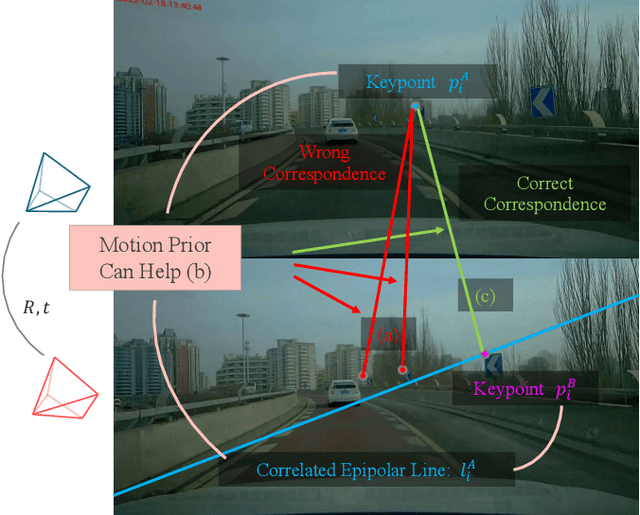

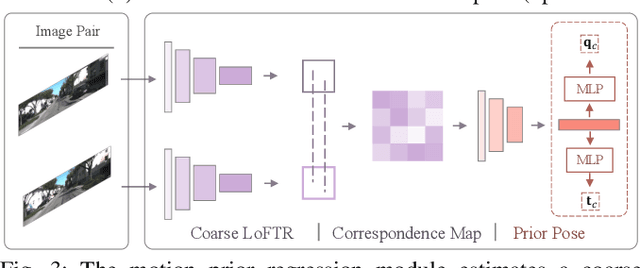

Abstract:Dashboard cameras (dashcams) record millions of driving videos daily, offering a valuable potential data source for various applications, including driving map production and updates. A necessary step for utilizing these dashcam data involves the estimation of camera poses. However, the low-quality images captured by dashcams, characterized by motion blurs and dynamic objects, pose challenges for existing image-matching methods in accurately estimating camera poses. In this study, we propose a precise pose estimation method for dashcam images, leveraging the inherent camera motion prior. Typically, image sequences captured by dash cameras exhibit pronounced motion prior, such as forward movement or lateral turns, which serve as essential cues for correspondence estimation. Building upon this observation, we devise a pose regression module aimed at learning camera motion prior, subsequently integrating these prior into both correspondences and pose estimation processes. The experiment shows that, in real dashcams dataset, our method is 22% better than the baseline for pose estimation in AUC5\textdegree, and it can estimate poses for 19% more images with less reprojection error in Structure from Motion (SfM).
E$^3$NeRF: Efficient Event-Enhanced Neural Radiance Fields from Blurry Images
Aug 03, 2024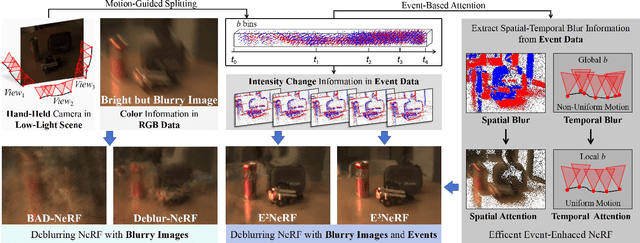

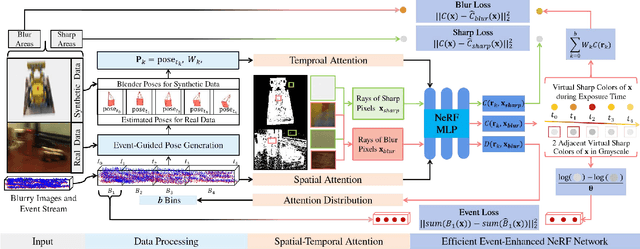

Abstract:Neural Radiance Fields (NeRF) achieve impressive rendering performance by learning volumetric 3D representation from several images of different views. However, it is difficult to reconstruct a sharp NeRF from blurry input as it often occurs in the wild. To solve this problem, we propose a novel Efficient Event-Enhanced NeRF (E$^3$NeRF) by utilizing the combination of RGB images and event streams. To effectively introduce event streams into the neural volumetric representation learning process, we propose an event-enhanced blur rendering loss and an event rendering loss, which guide the network via modeling the real blur process and event generation process, respectively. Specifically, we leverage spatial-temporal information from the event stream to evenly distribute learning attention over temporal blur while simultaneously focusing on blurry texture through the spatial attention. Moreover, a camera pose estimation framework for real-world data is built with the guidance of the events to generalize the method to practical applications. Compared to previous image-based or event-based NeRF, our framework makes more profound use of the internal relationship between events and images. Extensive experiments on both synthetic data and real-world data demonstrate that E$^3$NeRF can effectively learn a sharp NeRF from blurry images, especially in non-uniform motion and low-light scenes.
Enhancing Monotonic Modeling with Spatio-Temporal Adaptive Awareness in Diverse Marketing
Jun 20, 2024Abstract:In the mobile internet era, the Online Food Ordering Service (OFOS) emerges as an integral component of inclusive finance owing to the convenience it brings to people. OFOS platforms offer dynamic allocation incentives to users and merchants through diverse marketing campaigns to encourage payments while maintaining the platforms' budget efficiency. Despite significant progress, the marketing domain continues to face two primary challenges: (i) how to allocate a limited budget with greater efficiency, demanding precision in predicting users' monotonic response (i.e. sensitivity) to incentives, and (ii) ensuring spatio-temporal adaptability and robustness in diverse marketing campaigns across different times and locations. To address these issues, we propose a Constrained Monotonic Adaptive Network (CoMAN) method for spatio-temporal perception within marketing pricing. Specifically, we capture spatio-temporal preferences within attribute features through two foundational spatio-temporal perception modules. To further enhance catching the user sensitivity differentials to incentives across varied times and locations, we design modules for learning spatio-temporal convexity and concavity as well as for expressing sensitivity functions. CoMAN can achieve a more efficient allocation of incentive investments during pricing, thus increasing the conversion rate and orders while maintaining budget efficiency. Extensive offline and online experimental results within our diverse marketing campaigns demonstrate the effectiveness of the proposed approach while outperforming the monotonic state-of-the-art method.
 Add to Chrome
Add to Chrome Add to Firefox
Add to Firefox Add to Edge
Add to Edge